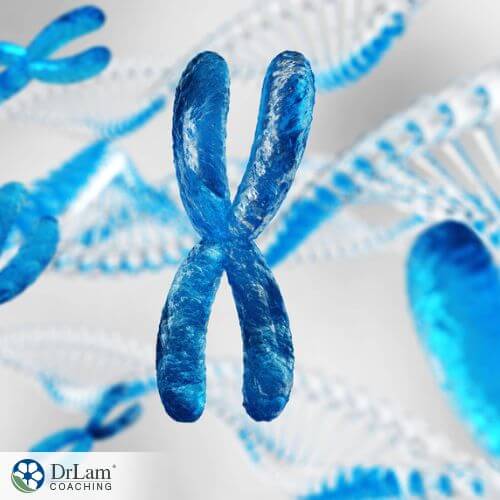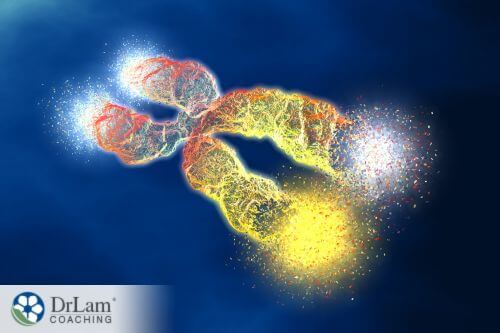 There is a link between shortened telomere length and lifespan. Telomeres protect the ends of the chromosomes that comprise your genomes. They are roughly 8,000-10,000 nucleotides in length, but they shorten each time a cell divides. And once telomeres reach a critical length, the cell no longer divides and dies. The shortening of telomeres has been linked to aging. However, research has shown that certain lifestyle choices and some potential scientific advances could help to lengthen telomeres.
There is a link between shortened telomere length and lifespan. Telomeres protect the ends of the chromosomes that comprise your genomes. They are roughly 8,000-10,000 nucleotides in length, but they shorten each time a cell divides. And once telomeres reach a critical length, the cell no longer divides and dies. The shortening of telomeres has been linked to aging. However, research has shown that certain lifestyle choices and some potential scientific advances could help to lengthen telomeres.
Telomeres are distinctive structures or protective caps on the ends of your chromosomes. They are comprised of the same short DNA sequence that repeats again and again. The sequence typically repeats roughly 3,000 times and can climb up to 15,000 base pairs long.
You can view telomeres as sequences of DNA chains of chemical code. They are comprised of four nucleic acid bases-- G, A, T, C. Specifically, G is for guanine, A is for adenine, T is for thymine, and C is for cytosine. The telomere sequence is TTAGGG in humans. Thus, telomere is a "repeat" made of six "base pairs". These are sequences of TTAGGG on one strand paired with AATCCC on the other strand.
The telomere is linked to several proteins that collectively create the Shelterin complex. This complex helps produce the final end cap structure of the chromosome. The proteins help to regulate the telomere length.
According to researchers Lee and Pellegrini, the main function of a telomere is to maintain chromosomal stability and prevent chromosomal degradation. Telomeres function as substrates for telomerase. This is the enzyme responsible for adding DNA to the ends of chromosomes and is involved in telomere repair and elongation, thus maintaining chromosome length and the longevity of cellular information. It’s produced by the germ-line cells and a few somatic cells.
Specifically, the primary functions of telomeres are:
Your chromosomes get shorter by roughly 25-200 bases per replication each time a cell performs a DNA replication. However, since telomeres protect the ends of the chromosomes, the telomere is the only part of the chromosome that gets lost. The DNA remains intact and undamaged.
Telomeres are important because, without them, important DNA would be lost with each cell division. If there was no telomere, the eventual loss would be of entire genes, leading eventually to loss of life.
Short telomeres trigger the “Hayflick Limit” and drive premature aging. The Hayflick Limit refers to the limit on human cell replication resulting from the shortening of telomeres with each division.
During cell division, two main factors contribute to telomere shortening. These are:
The “end replication problem” during DNA replication can shorten telomeres. Specifically, the end replication problem occurs when the DNA at the very end of the chromosome cannot copy completely in each round of replication.
As a result, this causes a slow, gradual shortening of the chromosome. According to research, the “end replication problem” is responsible for the loss of roughly 20 base pairs with each cell division.
According to an article published in Genes, to avoid telomere loss, shelterin functions to recruit telomerase to elongate the G-rich strand by supporting telomere repeats.
 Telomere shortening can also result from oxidative stress and DNA damage. Oxidative stress refers to the damage to DNA, proteins, and lipids (fats) caused by oxidants (highly reactive substances).
Telomere shortening can also result from oxidative stress and DNA damage. Oxidative stress refers to the damage to DNA, proteins, and lipids (fats) caused by oxidants (highly reactive substances).
Based on an article in the journal Mechanisms of Ageing and Development, the inability to finish DNA replication to the chromosome ends leads to the gradual loss of roughly 20–50 base pairs in each cell division. As a result, chromosome shortening occurs progressively during cell replication and is seen with aging. Furthermore, lifestyle factors, including diet, smoking, and stress, can impact the levels of oxidative stress in your body.
In the instance of a telomere becoming too short, the chromosome reaches a ‘critical length’ and will fail to replicate. Subsequently, this ’critical length’ causes the cell to die via programmed cell death.
Still, other factors that could shorten telomere include physiological and psychological stress, nutrient deficiencies, and cortisol.
The older you get, the telomere length decreases. For instance, in white blood cells, telomeres' length ranges from 8,000 base pairs in newborns to 3,000 base pairs in adults. By the time a person is elderly, it can be 1,500 base pairs. There are roughly 150 million base pairs in one complete chromosome. A cell can experience a decline of 30 to 200 base pairs from the ends of its telomeres every time that it divides.
Furthermore, with cells typically dividing only roughly 50 to 70 times, telomeres gradually get shorter until cellular senescence, where the cells grow old and eventually stop dividing or die. However, in tissues where cells are not continually dividing, like the heart muscle, telomeres do not shorten.
In essence, telomere shortening and damage are causes of cellular senescence and aging according to research.
The exact causes of aging are still a mystery, but telomeres may offer some insight into this long-standing mystery. A study in the journal GeroScience suggests that telomere length could affect how old a person looks. Researchers involved in the study analyzed survey results from more than 400,000 participants in the UK Biobank. Subsequently, they found that people who had genetic predictors of longer telomere length were more often said to look younger than their age.
A study conducted by scientists at the University of Utah discovered that shorter telomeres are associated with shorter lives. Their findings indicate that people over the age of 60 with shorter telomeres were 3 times more likely to die from heart disease and 8 times more likely to die from infectious disease. However, one thing that remains unclear is whether shorter telomeres are simply a sign of aging or contribute to aging.
In another study, researchers looked at how big a role telomeres play in aging. Researchers found that of two groups divided based on telomere length, on average, the group with longer telomeres lived five years longer than those with shorter telomeres.
However, it’s important to note that people with longer telomeres still experience telomere shortening with age. Still, if it were possible to stop telomere shortening entirely, researchers believe that persons could add between 10 years and 30 years to their lifespan.
 Stress is one of several factors that may contribute to telomere shortening. In people with Adrenal Fatigue Syndrome (AFS), the non-Addison's form of adrenal dysfunction where the body's stress response cannot keep up with life's chronic stressors, chronic stress is a key feature.
Stress is one of several factors that may contribute to telomere shortening. In people with Adrenal Fatigue Syndrome (AFS), the non-Addison's form of adrenal dysfunction where the body's stress response cannot keep up with life's chronic stressors, chronic stress is a key feature.
In general, stress speeds up aging by disrupting cellular function, and this is worsened with chronic stress. This may cause symptoms of aging to emerge. Furthermore, the stress hormone cortisol can regulate telomerase function. Some research links telomere shortening to increases in stress-related cortisol, but the effects of cortisol on the telomere system may depend on the intensity and duration of exposure to the hormone. Thus, reducing stress and managing stress-related disorders could play a role in protecting the length of telomeres.
There is a connection between the shortening of telomeres and cancer. Cancer is characterized by fast and out-of-control cell division. This uncharacteristic cell division is possible because telomerase is significantly active in cancer cells. According to studies, telomerase maintains telomere length in the majority of cancer cells. As such, oftentimes, these cells escape death because of the production of more telomerase enzymes, which prevents the telomeres from shortening.
One scientific review suggests that telomerase is active in 85–95% of cancers. Still, many cancers including pancreatic, bone, prostate, bladder, lung, kidney, and head and neck cancer have shortened telomeres. Research findings indicate that without telomerase, cancer cells would deactivate, stop dividing, and, in time, go through apoptosis. However, inhibiting telomerase activity has the potential to have a negative impact on all cells that depend on the enzyme. These include sperm and immune cells. If this should happen, fertility issues and problems with immune response to infection could occur.
Scientific techniques and certain lifestyle choices can help to rebuild or lengthen telomeres after they become short. A focus on physical activities and nutrition can play a role in lengthening telomeres.
Scientific findings reveal that exercise can help lengthen your telomeres. This is due to the potential of exercise to stimulate your body's production of the telomerase, which is responsible for adding DNA to the telomeres. Also, aerobic or cardio exercise appears to be the most effective form of exercise for keeping telomeres in tip-top shape.
The findings in a study published in the European Heart Journal indicate that a single 45-minute jog increased telomerase activity in people exercising for several hours afterward. Specifically, following a three-times-per-week workout for six months, the participants’ (joggers and HIIT group) telomere length increased by 3 to 4 percent. Furthermore, the researchers found that the participants who lifted weights did not experience a spike in telomere length.
Essentially, both endurance and interval exercise can trigger the cells on the interior lining of the blood vessels and increase telomerase as a result. However, a single workout is inadequate to lengthen telomeres. In fact, people should perform regular cardio workouts for six months or more to achieve telomere-lengthening results.
 The consumption of certain foods can help to increase telomere length.
The consumption of certain foods can help to increase telomere length.
According to an article in the journal Nutrients, telomere length is positively linked to the consumption of foods like legumes, nuts, seaweed, fruits, 100% fruit juice, dairy products, and coffee. However, the consumption of alcohol, processed meat, and red meat has the opposite effect.
Studies suggest that an association may exist between a reduction in sugary beverage consumption and extended telomere length Examples of sugary beverages include fruit-flavored drinks, energy drinks, diet sodas, soda, soft drinks, and sports drinks. Still, while it’s important to look at the effects of individual foods on telomere length, the role of overall nutrient intake in specific diets should also be observed.
There is a linkage between the Mediterranean Diet and preventing age-associated telomere shortening. This diet is among the best models of healthy, nutrient-rich eating. It involves a high consumption of cereals (mainly unrefined), fruits, legumes, vegetables, and nuts, and a moderate to high intake of fish. A low consumption of saturated fats but a high intake of unsaturated fats, especially olive oil, and a moderate intake of alcohol, particularly wine, on a regular basis are also features of this diet.
It appears that there’s a connection between unhealthy dietary habits and an inflammatory state that contributes to progressive telomere erosion. Unhealthy diets increase the production of reactive oxygen species (ROS), and so the potential to impact telomere erosion through an increased oxidation of telomeric DNA may be possible. In that vein, an antioxidant or anti-inflammatory diet, like the Mediterranean Diet, could protect telomeres by reducing inflammation.
Researchers at Stanford found a new way to lengthen human telomeres by as much as 1,000 nucleotides. Modified messenger RNA was employed by the researchers to lengthen the telomeres. RNA plays the role of a carrier, taking instructions from genes in DNA to where the cells make their protein. Researchers used RNA containing the coding sequence for TERT, the active component of the enzyme telomerase. However, this disappears within 48 hours, and the newly extended telomeres gradually shorten again with each cell division. Still, the researchers’ findings reveal that three applications of the modified RNA in just a few days have the potential to significantly increase telomeres’ length by up to 10%.
With each cell division, telomeres get shorter and shorter. As you age, they wear away. According to research, telomeres regenerate in stem cells and some cancer cells. Additionally, findings suggest that some lifestyle changes have the potential to make them do so in ordinary cells. High-intensity aerobic exercise and certain diets such as the Mediterranean diet, as mentioned earlier, can help to lengthen telomeres. Limiting stress could also help to protect telomeres.
Telomere length appears to play a role in aging and health. Shorter telomeres may be a marker of aging or a cause of it. And studies have connected shorter telomeres with a higher risk of death. However, maintaining a healthy diet and exercise regimen could help lengthen telomeres, and future therapies may help as well.
If you would like to learn more about natural ways to turn back the clock on aging, the team at Dr. Lam Coaching can help. We offer a free** no-obligation phone consultation at +1 (626) 571-1234 where we will privately discuss your health concerns and various options. You can also send us a question through our Ask The Doctor system by clicking here.
Balan, Estelle, et al. "Physical Activity and Nutrition: Two Promising Strategies for Telomere Maintenance?" Nutrients, vol. 10, no. 12, 2018, https://doi.org/10.3390/nu10121942.
Lee, J., Pellegrini, M.V. "Biochemistry, Telomere and Telomerase." StatPearls [Internet]. Treasure Island (FL): StatPearls Publishing; 2023 Jan. Updated 2022 Dec 11. https://www.ncbi.nlm.nih.gov/books/NBK576429/.
Maestroni, Laetitia, et al. "Solving the Telomere Replication Problem." Genes, vol. 8, no. 2, 2017, https://pubmed.ncbi.nlm.nih.gov/28146113/.
Shammas, Masood. "Telomeres, Lifestyle, Cancer, and Aging." Current Opinion in Clinical Nutrition and Metabolic Care, vol. 14, no. 1, 2011, p. 28, https://pubmed.ncbi.nlm.nih.gov/21102320/.
Trybek, T., Kowalik, A., Góźdź, S., Kowalska, A. "Telomeres and Telomerase in Oncogenesis (Review)." Oncology Letters, vol. 20, no. 2, 2020, pp. 1015-1027. https://pubmed.ncbi.nlm.nih.gov/32724340/.
Werner, Christian M., et al. "Differential Effects of Endurance, Interval, and Resistance Training on Telomerase Activity and Telomere Length in a Randomized, Controlled Study." European Heart Journal, vol. 40, no. 1, 2019, pp. 34–46. https://pubmed.ncbi.nlm.nih.gov/30496493/.
Zhan, Yiqiang, and Sara Hägg. "Association between Genetically Predicted Telomere Length and Facial Skin Aging in the UK Biobank: A Mendelian Randomization Study." GeroScience, vol. 43, no. 3, 2021, pp. 1519-1525. https://pubmed.ncbi.nlm.nih.gov/33033864/.
Some reasons for telomere shortening are oxidative stress, end replication problem, nutrient deficiency, and stress. You can lengthen them by performing regular aerobic exercise, sticking to a nutrient-rich diet, and with the help of modified messenger RNA.
